What is Gyrocopters? Gyrocopter also known as gyroplanes, are a type of rotary wing aircraft that offer a unique and thrilling flying experience. Unlike traditional airplanes, gyrocopters feature rotor blades that rotate freely in the wind, creating lift.
Contents
However, unlike helicopters, gyrocopters do not have a powered rotor and rely on an engine-driven propeller for thrust.
This unique design gives gyrocopters a range of benefits, including increased stability and maneuverability.
Since their invention, gyrocopters have captured the imagination of aviation enthusiasts around the world.
From recreational flying to specialized applications in industries such as agriculture, surveillance, and more, gyrocopters continue to offer a range of exciting possibilities.
Key Takeaways
- Gyrocopters are a type of rotary wing aircraft that use freely rotating rotor blades for lift.
- They rely on an engine-driven propeller for thrust, distinguishing them from helicopters.
- Gyrocopters offer increased stability and maneuverability compared to traditional airplanes.
- They have a wide range of applications in industries such as agriculture, surveillance, and more.
- Gyrocopters offer a unique and exciting flying experience for aviation enthusiasts.
What Is Gyrocopter?: The Evolution of Gyrocopters
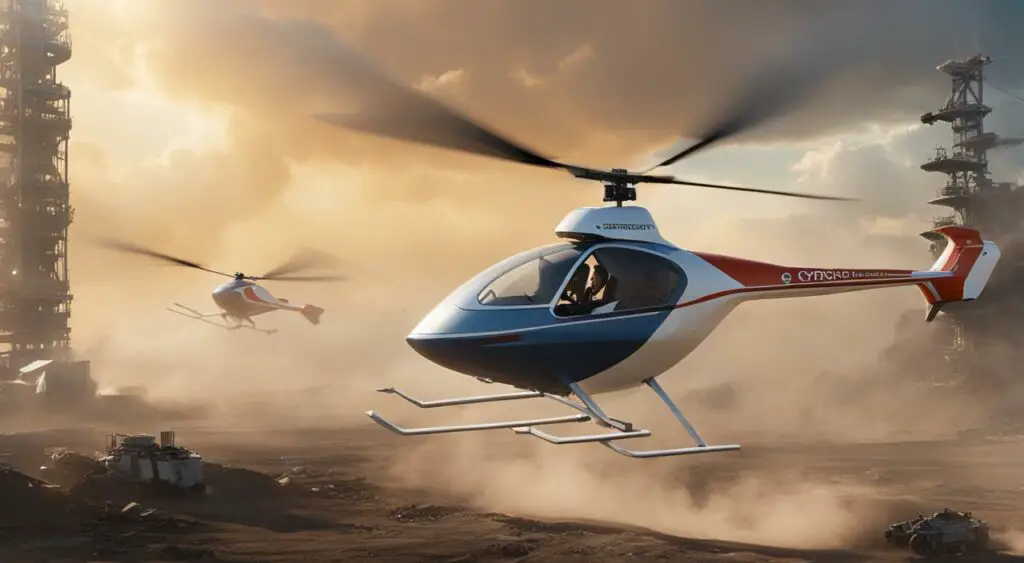
Gyrocopters have a rich history dating back to the early 1920s. Hungarian engineer, Dr. George de Bothezat, and Russian engineer, Ivan Jerome, are credited with building the first gyroplane.
However, it wasn’t until Spanish engineer, Juan de la Cierva, introduced the autogiro design in the mid-1920s that gyrocopters began to gain traction.
The autogiro design featured a rotor that was freely spinning and not powered, with lift generated by forward motion. This design eliminated the risk of stalling and allowed for smoother flights.
The autogiro design proved to be so successful that it was eventually adopted by the military for reconnaissance purposes during World War II.
In the 1950s and 1960s, gyrocopters saw a resurgence in popularity, with a number of notable advancements being made in the field.
German aeronautical engineer, Friedrich von Doblhoff, invented the compound gyroplane, which featured a rotor system that could be powered for vertical takeoff and landing, as well as forward flight.
During the 1980s and 1990s, gyrocopters continued to evolve, with improvements made in design, safety, and performance.
Computer-aided design and composite materials were used to create lighter and more efficient models. Gyrocopters also gained popularity in the recreational market, with enthusiasts around the world taking up the hobby.
Today, gyrocopters continue to be a popular alternative to traditional fixed-wing aircraft and helicopters, with ongoing advancements being made in the field.
How Gyrocopters Work
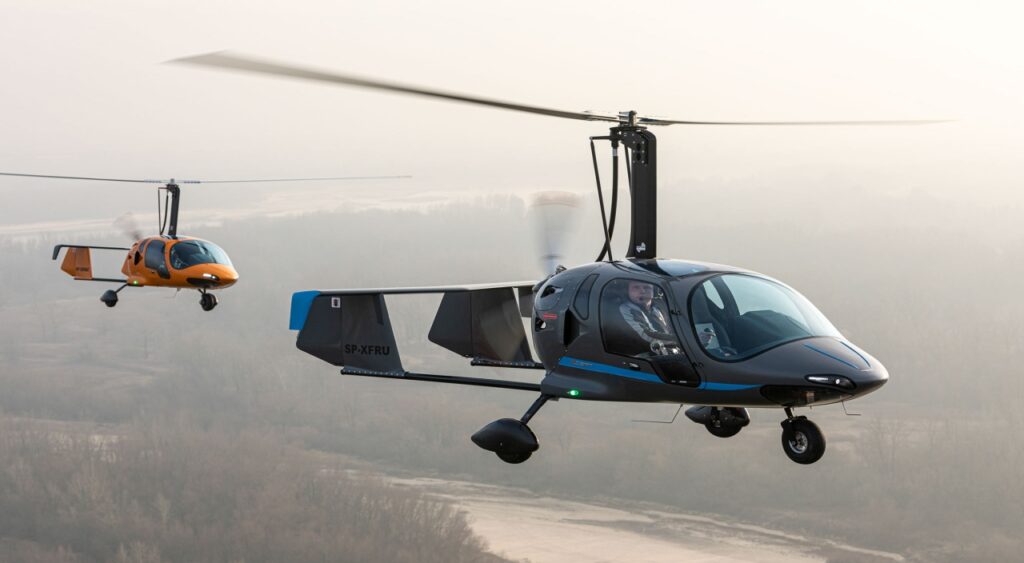
Gyrocopters, also known as autogyros, are rotary wing aircraft that use unpowered rotor blades to generate lift.
Unlike helicopters, gyrocopters’ rotor blades are not powered by an engine but instead rotate freely due to the forward motion of the aircraft.
This motion creates lift, allowing the gyrocopter to take off and fly. The lift generated by the rotor blades is controlled by the pilot using a control stick, which adjusts the rotor pitch.
This allows for varying degrees of lift and descent. The pilot also controls the direction of flight and speed using pedals and a throttle, respectively.
One key component of gyrocopter flight is the use of gyroscopes. The rotor blades are mounted on a mast, which is itself connected to a rotor head.
The rotor head is connected to a gyroscope, which helps stabilize the aircraft and maintain proper pitch, roll, and yaw.
Rotary Wing Design
The rotary wing design of gyrocopters is what sets them apart from other aircraft.
This design allows for vertical takeoff and landing, as well as the ability to fly at slower speeds and in tighter spaces than fixed-wing aircraft.
The rotor blades on a gyrocopter operate differently from those on a helicopter. On a helicopter, the rotor blades are powered by an engine and can be adjusted to generate lift and torque.
On a gyrocopter, the rotor blades are not powered directly but instead rotate due to the airflow created by the forward motion of the aircraft.
This design also means that gyrocopters do not require a runway to take off or land. They can take off vertically, even from a stationary position, and land in a relatively small space.
This makes them useful for a wide range of applications, including search and rescue, aerial photography, and agriculture.
Flight Mechanics
Gyrocopters can fly at relatively slow speeds, typically between 25 and 100 miles per hour, depending on the model.
This makes them useful for applications such as aerial mapping and surveying, where slower speeds allow for more detailed and accurate data collection.
One key aspect of gyrocopter flight is autorotation. This occurs when the rotor blades are allowed to spin freely, without power from the engine.
In this state, the rotor blades are still generating lift due to the forward motion of the aircraft, but there is no torque being generated.
This allows the gyrocopter to glide safely to the ground in case of engine failure.
“The rotor blades of a gyrocopter are not powered by an engine but instead rotate freely due to the forward motion of the aircraft.”
Gyrocopter vs Helicopter: Key Differences
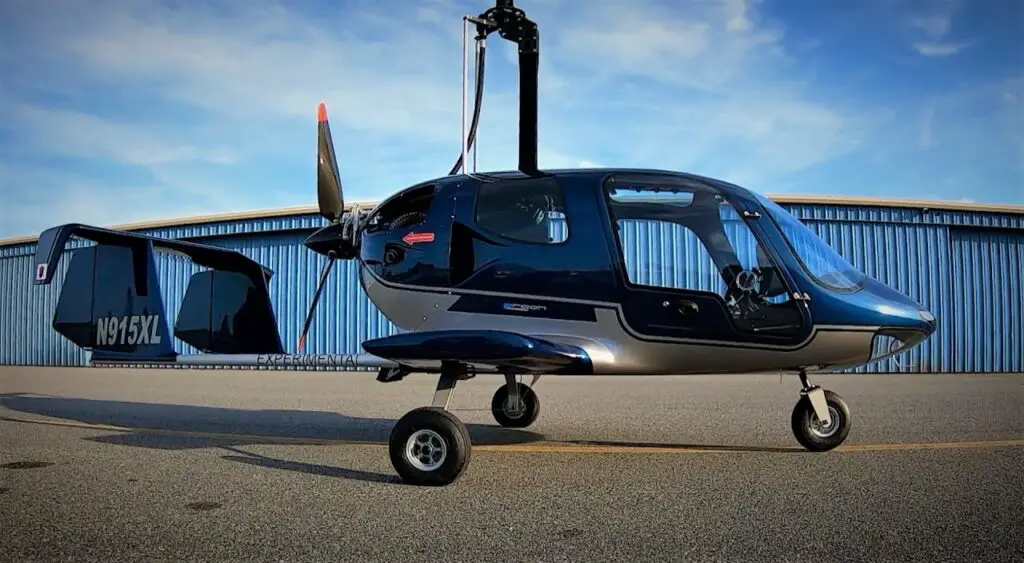
While gyrocopters and helicopters share some similarities, they also have fundamental differences in their design and flight capabilities.
Gyrocopter Design
A gyrocopter is a rotary wing aircraft with a free-spinning rotor blade that provides lift and an engine-driven propeller that provides thrust.
Unlike a helicopter, a gyrocopter’s rotor blade is not powered and instead rotates freely as the aircraft moves forward. This means that the rotor blade provides lift only and does not control the aircraft’s direction of travel.
Helicopter Design
A helicopter, on the other hand, has a powered rotor blade that provides both lift and directional control. The angle of the rotor blades can be changed to allow the helicopter to move forward, backward, and sideways.
Flight Capabilities
| Gyrocopter | Helicopter | |
|---|---|---|
| Lift | Passive rotor blade provides lift only | Powered rotor blade provides lift and directional control |
| Speed | Slower speeds, typically between 50-90 mph | Faster speeds, some models can reach over 200 mph |
| Maneuverability | Good stability and maneuverability in calm weather | Highly maneuverable, can perform complex aerial maneuvers |
| Cost | Less expensive to manufacture and maintain | More expensive to manufacture and maintain |
| Applications | Recreational flying, aerial photography, agricultural surveys | Search and rescue, military operations, medical transport |
As the table shows, gyrocopters and helicopters have different performance capabilities that make them suited for different applications.
Gyrocopters are slower and less maneuverable than helicopters, but they are more cost-effective and can be used for a variety of tasks such as recreational flying, aerial photography, and agricultural surveys.
Helicopters, on the other hand, are highly maneuverable and can perform complex aerial maneuvers, making them suitable for tasks such as search and rescue, military operations, and medical transport.
Overall, while there are some similarities between gyrocopters and helicopters, their unique design and flight capabilities make them distinct aircraft that are suited for different purposes.
Advantages and Disadvantages of Gyrocopters
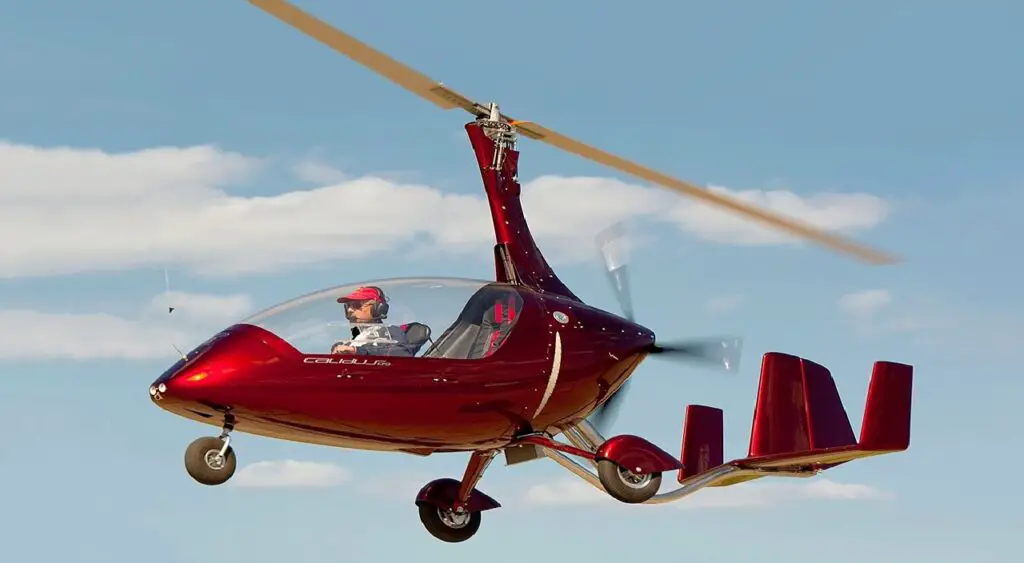
Gyrocopters are gaining popularity as a cost-effective and versatile option for aviation enthusiasts and industry professionals alike.
However, as with any aircraft, there are advantages and disadvantages to consider before taking to the skies.
Advantages of Gyrocopters
- Cost-effective: Gyrocopters are generally less expensive to purchase and maintain than traditional helicopters, making them an attractive option for those on a budget.
- Stability: The rotor blades of a gyrocopter provide stability in flight, making it less susceptible to turbulence and wind gusts compared to fixed-wing aircraft.
- Short takeoff and landing: Gyrocopters require less runway space than traditional airplanes, allowing for takeoffs and landings in smaller areas.
- Low speed: Gyrocopters can fly at lower speeds than helicopters, making them ideal for aerial photography and observation.
- Versatility: Gyrocopters can operate in a variety of environments, including urban, rural, and maritime settings, making them useful for a wide range of applications.
Disadvantages of Gyrocopters
- Weather limitations: While gyrocopters are stable in mild turbulence, they can be grounded in heavy rain or high winds.
- Noise: Gyrocopters can be noisy in flight, which may be a concern for pilots and passengers.
- Lower speed: While lower speeds are an advantage for some applications, they can be a disadvantage for long-distance travel or time-sensitive missions.
- Pilot training: Gyrocopters require specialized training and certification, which can be a significant investment of time and money.
- Safety concerns: As with any aircraft, gyrocopters carry inherent safety risks that must be taken seriously and managed appropriately.
Gyrocopter Safety and Regulations
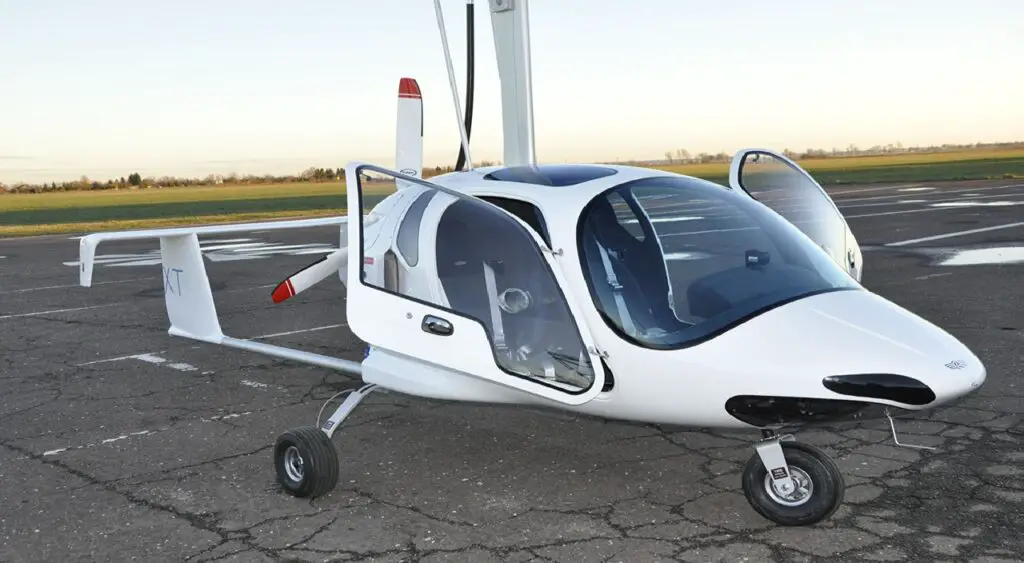
As with any aircraft, safety is of utmost importance when flying gyrocopters. These unique flying machines require specific training, maintenance, and adherence to regulations to ensure safe flight operations.
Gyrocopter Pilot Training
Getting trained as a gyrocopter pilot is essential to ensure safe flight operations. The pilot must undergo formal training, which includes both ground and flight instruction.
The ground instruction should cover various topics such as aerodynamics, aircraft systems, and emergency procedures.
During the flight instruction, the pilot will learn how to take off, fly, and land the gyrocopter safely. The pilot must log a specific number of flight hours before qualifying for a gyrocopter pilot license.
Gyrocopter Maintenance
Gyrocopters must undergo regular maintenance to ensure they are in top condition for safe flight operations.
The owner of the gyrocopter must follow the manufacturer’s guidelines for maintenance and have the aircraft inspected by a certified mechanic regularly.
Any defects or damage must be repaired promptly before the gyrocopter takes flight.
Gyrocopter Regulations
Gyrocopters are subject to regulations set forth by the Federal Aviation Administration (FAA). These regulations outline the minimum standards for gyrocopter design, operation, and safety.
Pilots must adhere to these regulations, which cover aspects such as airspace restrictions, flight limitations, weight restrictions, and pilot requirements.
Gyrocopter Safety Tips
Aside from proper training and maintenance, there are several safety tips that gyrocopter pilots should follow. These tips include:
- Checking weather and wind conditions before flying and avoiding flying in adverse weather conditions.
- Performing pre-flight inspections before every flight to ensure the gyrocopter is in top condition.
- Wearing proper safety gear such as helmets and harnesses.
- Keeping a safe distance from other aircraft and obstacles during flight.
- Being vigilant about fuel levels and avoiding running out of fuel mid-flight.
It is better to be on the ground wishing you were in the air than to be in the air wishing you were on the ground.
Overall, gyrocopters are safe to fly as long as pilots follow proper training, maintenance, and regulations. By prioritizing safety, gyrocopter pilots can enjoy the unique experience of flying these fascinating machines.
The Benefits and Applications of Gyrocopters
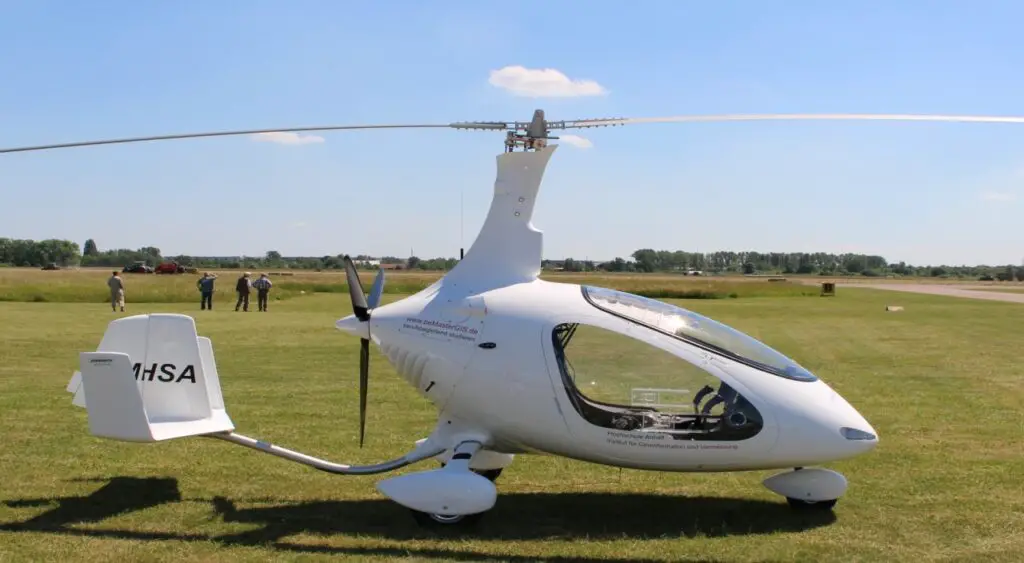
Gyrocopters offer a wide range of benefits and applications beyond recreational flying. Whether it’s aerial photography, surveillance, or agriculture, gyrocopters have proven to be a versatile and valuable tool in various industries.
- Gyrocopters are cost-effective: Compared to other aircraft such as helicopters, gyrocopters are relatively affordable to purchase and maintain. This makes them a popular choice for those who want to experience the thrill of flying without breaking the bank.
- Gyrocopters are stable: Due to their unique design with rotor blades, gyrocopters are inherently stable in flight. They are less affected by turbulence and wind gusts, making them a safer option in certain conditions.
- Gyrocopters are versatile: Gyrocopters can be used in a wide range of industries such as agriculture, wildlife management, and search and rescue operations. They can easily access hard-to-reach areas and provide a bird’s eye view that is not possible with other aircraft.
- Gyrocopters are environmentally friendly: Gyrocopters have lower fuel consumption compared to other aircraft, making them a more sustainable option for flying. They also produce lower noise pollution, making them a popular choice in areas sensitive to noise.
Aerial Photography and Filmmaking
Gyrocopters are increasingly being used in aerial photography and filmmaking.
With their stability in flight and ability to access hard-to-reach areas, gyrocopters can provide stunning aerial shots that are not possible with other aircraft.
They are also quieter than helicopters, making them a better choice for capturing audio during filming.
Surveillance and Security
Gyrocopters are also used in surveillance and security operations. They can easily access remote areas and provide real-time aerial footage for situational awareness.
Their stability in flight and low noise profile make them a popular choice for law enforcement and military applications.
Agriculture
Gyrocopters are becoming increasingly popular in agriculture due to their ability to access hard-to-reach areas and provide real-time aerial footage of crops.
This allows farmers to monitor crop health, identify problem areas, and make informed decisions to maximize crop yield.
Overall, gyrocopters offer a unique and versatile flying experience with a wide range of applications beyond recreation.
Gyrocopter Buying Guide

If you’re considering purchasing a gyrocopter, there are several important factors to keep in mind. Here’s a comprehensive buying guide to help you make an informed decision:
Factors to Consider
Usage: Before making a purchase, consider the intended use of the gyrocopter.
Will it be used for recreational flying or for specialized industries such as aerial photography, agriculture or surveillance? This will help determine the necessary features and specifications.
Cost: Gyrocopters vary in price, ranging from around $10,000 for used models to upwards of $100,000 for newer, specialized models.
Consider your budget and compare prices across different manufacturers.
Manufacturer: Research the reputation and history of potential gyrocopter manufacturers. Look for reviews and ratings from other owners and industry experts to ensure you’re buying from a reputable source.
Maintenance: Maintenance requirements for gyrocopters can vary depending on the model and usage. Consider the necessary upkeep and associated costs before making a purchase.
Resources for Finding Reputable Manufacturers
Industry Publications: Magazines such as Gyrocopter Magazine and Gyroplanes are great resources for finding reputable manufacturers and keeping up-to-date with industry news.
Gyroplane-Specific Websites: Websites such as Gyrocopter.com and Gyroplanes.org offer directories of manufacturers and dealers, as well as articles and forums for discussion with other gyrocopter enthusiasts.
The Buying Process
Once you’ve determined the necessary features and budget for your gyrocopter, it’s important to take the time to test and inspect potential models before making a purchase.
Here are some steps to take during the buying process:
- Arrange for a test flight with the manufacturer or dealer to get a feel for the gyrocopter’s handling and performance.
- Inspect the gyrocopter thoroughly for any signs of wear or damage, including the rotor blades, engine, and control systems.
- Check the paperwork and documentation, including maintenance records and registration, to ensure everything is in order.
With careful consideration and research, purchasing a gyrocopter can be a rewarding and exciting investment.
Notable Gyrocopter Models

If you’re interested in buying a gyrocopter, there are several notable models available on the market.
Each model has its unique features and capabilities, making it important to research which one is the best fit for your needs. Some popular gyrocopter models include:
AutoGyro Calidus
The AutoGyro Calidus is a two-seat, open-cockpit gyrocopter with a streamlined design for optimal performance. It has a maximum speed of 105 mph and a range of up to 500 miles.
Additionally, it has a maximum takeoff weight of 1,102 lbs, making it suitable for a wide range of pilots.
Cavalon Pro
The Cavalon Pro is a popular choice for those in search of a more luxurious gyrocopter. It features a comfortable cabin with leather seats and a sleek, modern design. It also has a top speed of 120 mph and a range of up to 430 miles.
ELA Aviacion ELA-07
The ELA Aviacion ELA-07 is a high-performance gyrocopter with a maximum speed of 115 mph and a range of up to 620 miles.
It has a streamlined design for optimal aerodynamics and efficiency.
Rotorsport UK MT-03
The Rotorsport UK MT-03 is a nimble and responsive gyrocopter with a top speed of 105 mph and a range of up to 372 miles.
It has a compact design, making it easy to store and transport. Ultimately, the best gyrocopter for you will depend on your specific needs and preferences.
Take the time to research different models and consult with professionals to determine which one is the best fit for you.

Conclusion
In conclusion, gyrocopters are a unique and fascinating flying machine that continue to capture the imagination of aviation enthusiasts around the world.
Their rotary wing design and versatile applications make them a popular choice for recreational flying, as well as specialized industries such as aerial photography, surveillance, and agriculture.
Considerations for Owning a Gyrocopter
Before purchasing a gyrocopter, it is important to consider various factors such as budget, maintenance requirements, and pilot training.
Additionally, resources such as reputable manufacturers and flying clubs can provide valuable guidance and support for prospective gyrocopter owners.
Notable Gyrocopter Models
Some popular and notable gyrocopter models include the AutoGyro Cavalon, Magni M16, and the RAF 2000 GTX-SE.
Each model offers unique features and capabilities, making them suitable for different purposes and preferences.
Overall, gyrocopters are a thrilling option to explore for those interested in aviation and aerial exploration.
With their unique design and versatile applications, they offer a truly unforgettable flying experience.

FAQ
-
What is a gyrocopter?
A gyrocopter, also known as a gyroplane, is a unique flying machine that utilizes rotor blades for lift and a propeller for propulsion. Unlike helicopters, gyrocopters do not have a powered rotor and rely on autorotation to maintain lift.
-
How does a gyrocopter work?
Gyrocopters work by utilizing the principles of autorotation. When the gyrocopter is in motion, the airflow through the rotor blades causes them to spin. This rotation creates lift, allowing the gyrocopter to fly. The propeller at the rear provides forward thrust.
-
What are the key differences between a gyrocopter and a helicopter?
The main differences between gyrocopters and helicopters lie in their design and flight characteristics. Gyrocopters rely on autorotation for lift, while helicopters have a powered rotor. Gyrocopters are typically more maneuverable at lower speeds and have a lower cost of ownership compared to helicopters.
-
What are the advantages and disadvantages of gyrocopters?
Gyrocopters offer several advantages such as cost-effectiveness, stability, and versatility in various applications. They are easier to fly compared to helicopters and have shorter takeoff and landing distances. However, gyrocopters can be limited in their payload capacity and are subject to weather conditions.
-
What are the safety measures and regulations associated with flying gyrocopters?
Flying a gyrocopter requires proper pilot training and adherence to safety regulations. Pilots must undergo gyrocopter-specific training and obtain the necessary licenses. Regular maintenance and inspections are crucial to ensure safe operations. Additionally, pilots must comply with airspace regulations and follow established flight procedures.
-
What are the benefits and applications of gyrocopters?
Gyrocopters have a wide range of benefits and applications beyond recreational flying. They are used for aerial photography, surveillance, agricultural spraying, search and rescue missions, and more. Gyrocopters provide a cost-effective and versatile solution for various industries.
-
What factors should I consider when choosing and owning a gyrocopter?
When choosing a gyrocopter, factors to consider include budget, intended use, maintenance requirements, and availability of spare parts. It’s important to research reputable manufacturers and consult with experienced gyrocopter pilots. Owning a gyrocopter requires regular maintenance, adherence to safety protocols, and compliance with regulatory requirements.
-
Are there notable gyrocopter models in the market?
Yes, there are several notable gyrocopter models available in the market. These models vary in features, performance, and suitability for different purposes. It’s recommended to consult with experts or attend gyrocopter exhibitions to learn about the latest models and their capabilities.
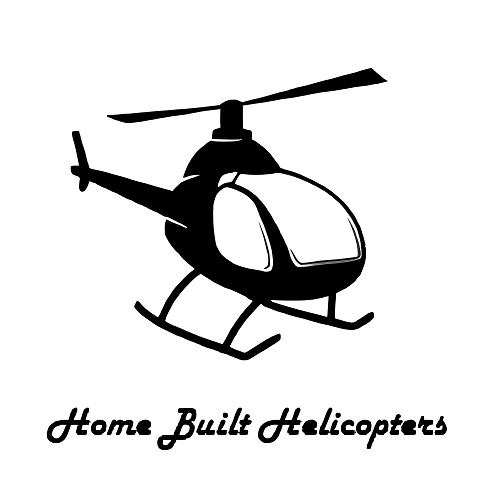
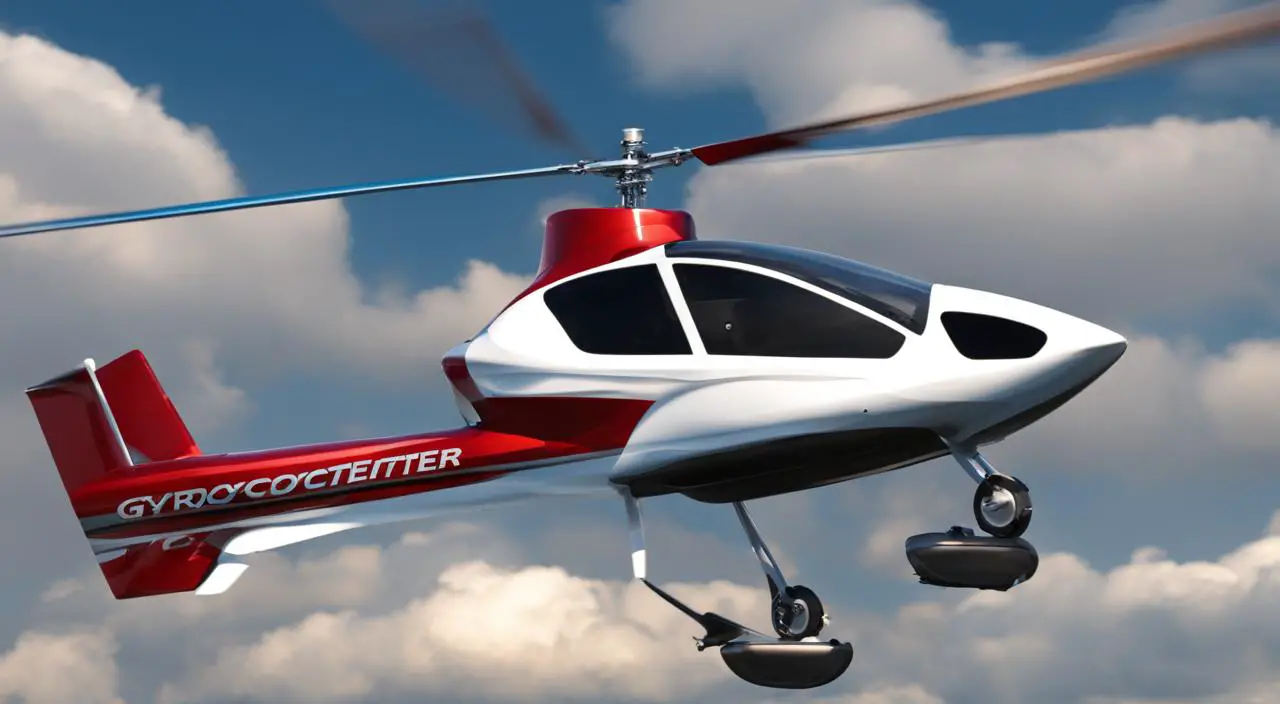
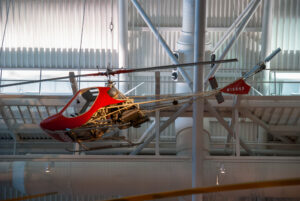
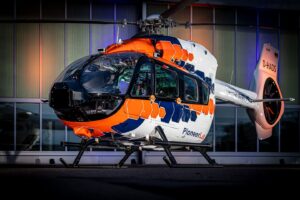

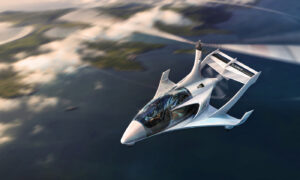
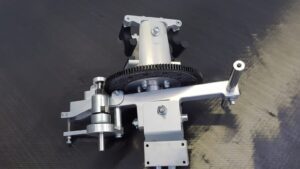
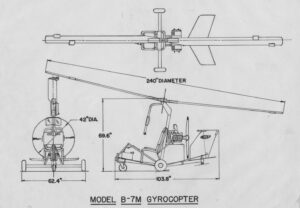
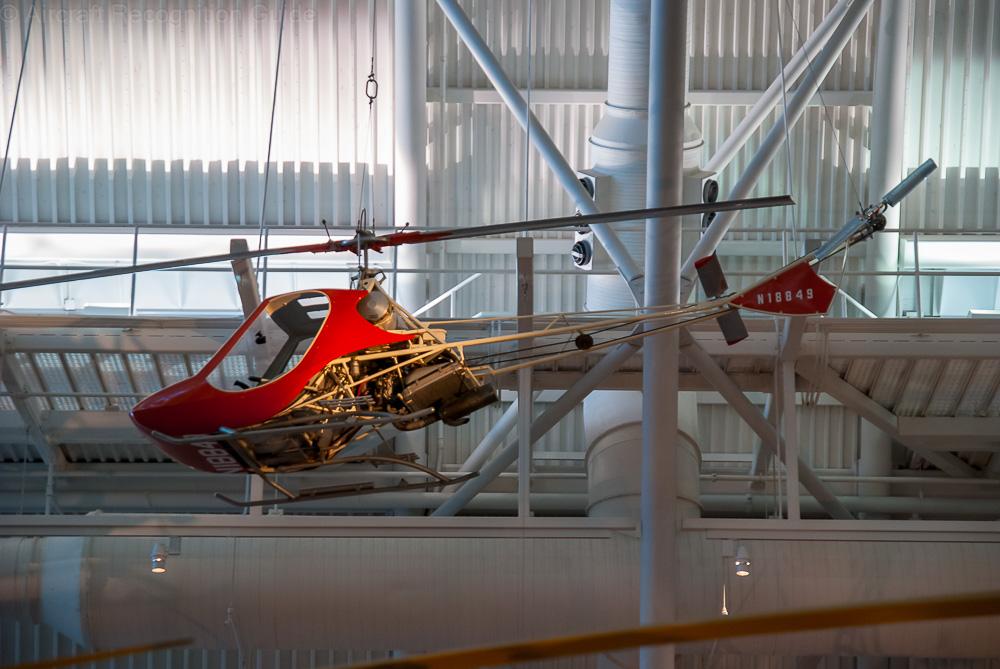


Leave a Reply